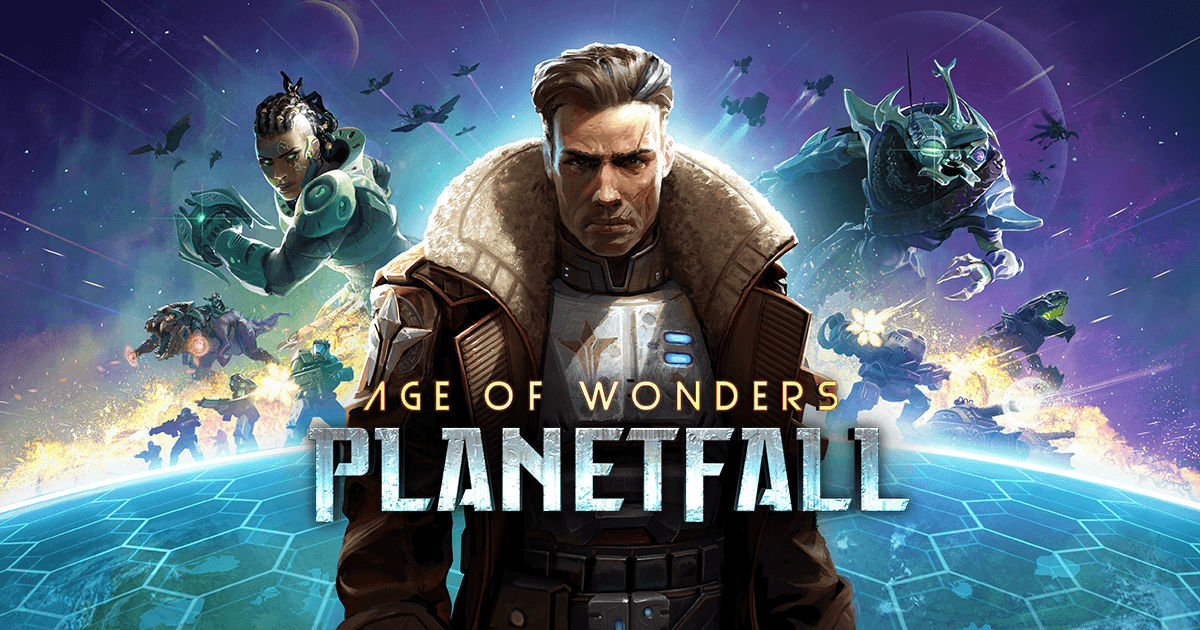
Age of Wonders is a long-running 4X fantasy franchise that first released at the tail end of the ’90s, but always remained moderately obscure. It certainly has its small and devoted fanbase, myself included, but when most people think of fantasy 4X classics, they probably think about the likes of Heroes of Might & Magic or newer games like Endless Legend. The series saw a resurgence in 2014 with Age of Wonders III, a game I thoroughly enjoyed despite some pretty significant flaws. Age of Wonders has always been a franchise that tries some unique and interesting ideas to set it apart from other fantasy 4X games, and just like many games in the genre, more than a handful of my Age of Wonders III sessions lasted until the first rays of sunlight crept through my window. I was very disappointed when Triumph Studios announced that they were done developing new content with the release of the Eternal Lords expansion, but they promised that there was a new project in development that fans would be interested in. That project ended up being Age of Wonders: Planetfall, a title that drastically departs from previous games by bring the franchise to the depths of space. Despite the shift in theme, Planetfall does an admirable job of transporting Age of Wonders III‘s core concepts and mechanics to the battlefields of the distant future.
Age of Wonders: Planetfall
Publisher: Paradox Interactive
Developer: Triumph Studios
Platforms: Windows PC (Reviewed), PS4, Xbox One
Release date: August 6th, 2019
Players: 1-12
Price: $49.99
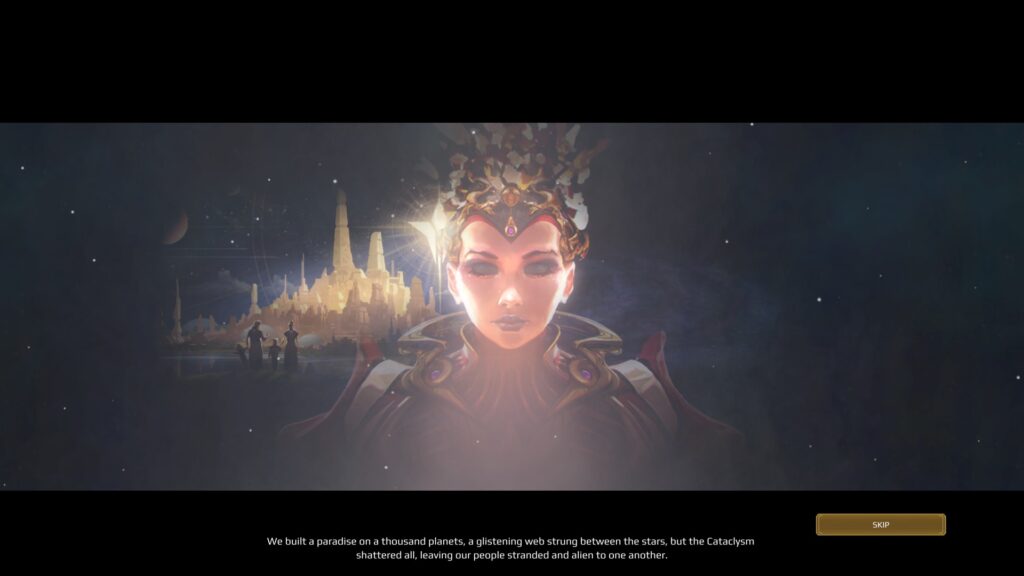
Age of Wonders: Planetfall is set hundreds of years after a galaxy-wide cataclysm that led to the collapse of the Star Union, an unimaginably massive unified government that spanned the cosmos. This mysterious cataclysm plunged the galaxy into a dark age of technological regression and complete anarchy. Now, six factions have emerged and begun to recolonize the galaxy to fill the power vacuum left behind by the absence of the Star Union.
The game has a branching campaign that tells the story of the emergence of viable new superpowers from the perspective of major leaders within each race. The story also expands upon the cause of the collapse of the Star Union, and the truth behind the apocalyptic event that dismantled any semblance of peace and order in the universe for several hundred years.
The narration and voice acting is decent enough, and the mission scenarios are definitely fun, but ultimately the campaign serves primarily as an extremely lengthy tutorial. This shouldn’t come as much of a surprise for any 4X veteran, as the real staying power in any game in the genre are the randomly generated scenario maps and community mods, the latter of which has a handy tab directly integrated in the game’s menus.
As I alluded to earlier, Planetfall features six playable races that run the gambit of standard sci-fi tropes and space versions of popular fantasy clichés. The Vanguard, for example, are your standard faction of sci-fi humans that represent a small expeditionary force of the Star Union that were in cryosleep due to a damaged warp drive when the cataclysm hit. They focus on ranged combat, with fireteams of space marines supported by combat drones, walkers, tanks, and VTOL gunships that are sent in when negotiations break down.
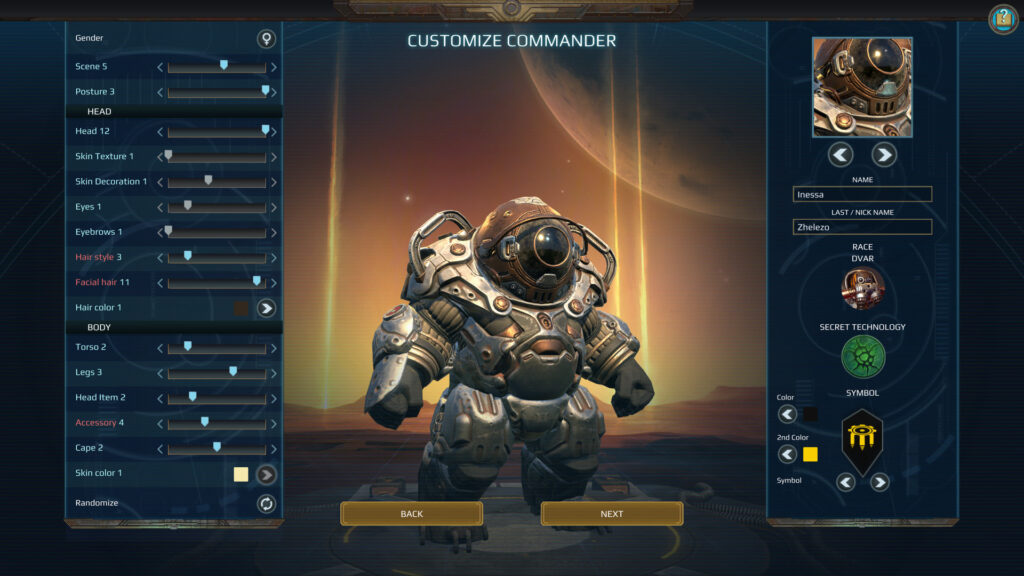
Personally, my favorite are the Dvar, a hardy race of dwarf-like humanoid aliens in hazardous environment suits that speak in thick Russian accents and sport a heavy Soviet motif. They have a big focus on industrial scale production due to their endless search for untapped veins of precious metals and valuable minerals, and many of their units and weapons have a utilitarian design that makes them look like repurposed mining equipment. They remind me a lot of the Squats, the beloved faction that Games Workshop cruelly took from us all those decades ago.
There’s a collection of minor NPC factions scattered around each map too, and while you can’t directly control them, you can acquire armies of their units by befriending them. Upon meeting an NPC faction, they’ll begin offering you quests that generally revolve around killing an enemy army, researching a technology, or producing something for them.
Completing these quests gives you some small rewards and influence with the faction. Influence is itself a major resource used in negotiating, and when it comes to NPC factions, you can spend Influence to buy technology and units from them. If they trust you enough, you can eventually absorb their territory. Alternatively, you could just outright conquer them, but this approach won’t net you all the benefits of trading with them.
The NPC factions, while not being completely playable and featuring less unit and mod options, can nonetheless provide you with tons of benefits when integrated into you budding empire. Their units often do unique or specialized things that can patch holes in your faction’s combat capabilities, and their mods are usually quite powerful and provide interesting synergies when applied to your own units and heroes.
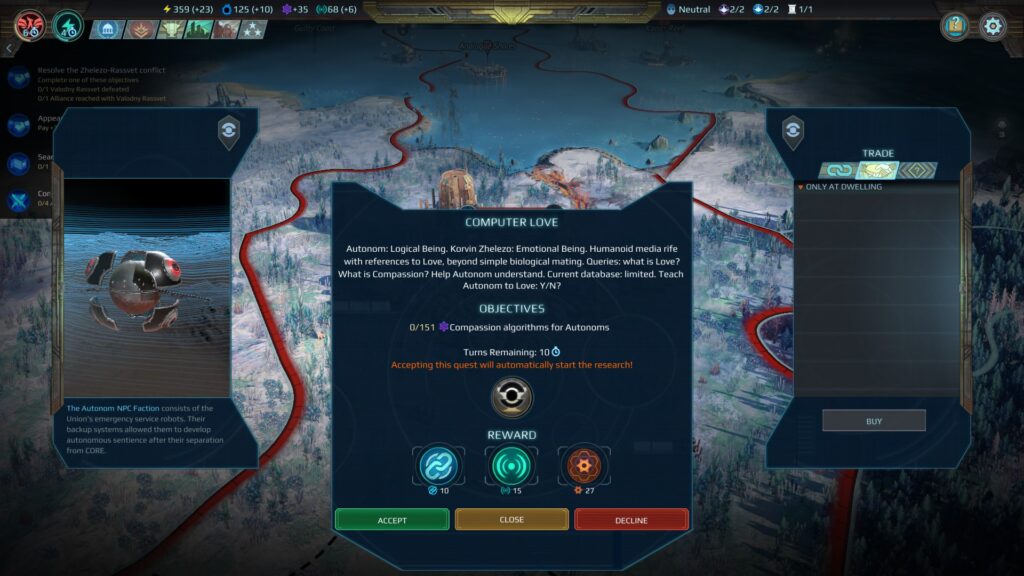
While the main factions reuse lots of generic colony upgrades and technology in their research trees, they still have plenty of unique concepts and mechanics to ensure that they all play very differently. In fact, Planetfall actually does a much better job than its predecessor when it comes to keeping the units and their uses distinct between each race, which was always one of my complaints with Age of Wonders III.
This was especially obvious in the earlier unit tiers. An orc spearman and a human halberdier were extremely similar in the previous game aside from some minor stat tweaks and racial weaknesses and immunities. In Planetfall, the Amazon Huntress and the Dvar Trencher may serve the same role as their race’s basic core infantry unit, but their weapons and abilities are dramatically different.
Each race has a set collection of units and technology to research, but your leader can further customize the way you play your favorite faction. The previous game had a class system, which opened up lots of new research options, units, and abilities depending on which class your leader was. In Planetfall you have the Secret Technology tree. There’s six Secret Technologies, and each one has unique units, upgrades, and mods that represent your leader using ancient -and in many cases, top secret and forbidden- technology from the Star Union era.
The Promethean technology tree consists of the weapons and equipment used by a secretive military unit tasked with completely erasing undesirable elements from the annuals of history. In gameplay terms, this means tons of plasma and fire weaponry. Another interesting Secret Technology is the Xenoplague, a highly contagious and rapidly spreading alien virus that reached a weaponized form due to careless research by geneticists. This tech tree allows you to infect enemies in battle, giving you a chance to spawn Xenoplague units after battle that evolve into more deadly variants as they gain experience.
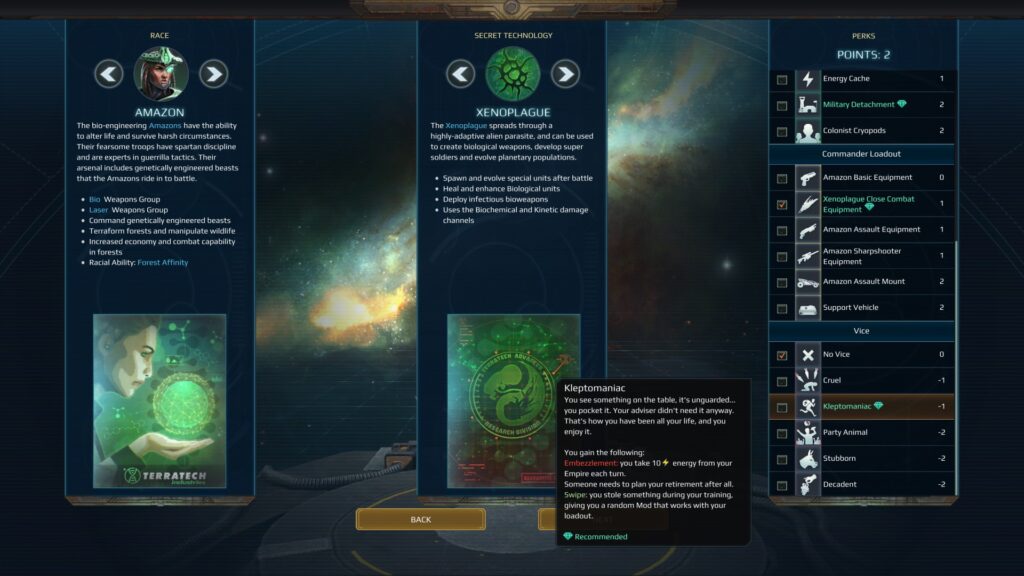
Secret Technology isn’t the only thing your leader offers. You can further customize your playstyle by putting points into various perks and backstories. These give you benefits, most of which focus on helping you early in a game by providing extra resources, units, or free technology. You can also customize your leader’s starting weapons, up to and including putting them in a vehicle. Finally, you can give them vices. These give you both a penalty and a small bonus, as well as extra points to improve your leader with extra or more expensive perks.
Your leader customization continues after planetfall as well, and extends to any heroes you recruit on your mission to exploit and enslave the unsuspecting natives of the planet you’ve come to conquer. Heroes level up just like all units, but upon leveling up you gain points that can be spent to purchase abilities. These can be active abilities, or passive effects that apply to all the units in their army stack. Heroes also have two slots for weapons, which can include various assault rifles, grenades, shotguns, rocket launchers, and more. As I mentioned earlier, you can also have your heroes pilot vehicles like tanks, APCs, or walkers if they have the proper piloting skills.
There’s three slots for mods too, and these extend to even your basic units. You can acquire new mods by researching them in the tech tree, trading for them with other empires, or as rewards from battles. These mods can grant all sorts of passive bonuses, and can drastically alter the way you use a unit. These mods also keep even the most basic of units relevant deep into the later stages of a game.
In Age of Wonders III, early game units became nearly useless later on as everyone built up the resources required to spam the high level units, but the introduction of mods ensures that nothing ever really becomes obsolete as the game progresses. You can make templates for your favorite unit mod combinations as well, allowing you to recruit them directly from a colony without having to individually equip the mods you want.
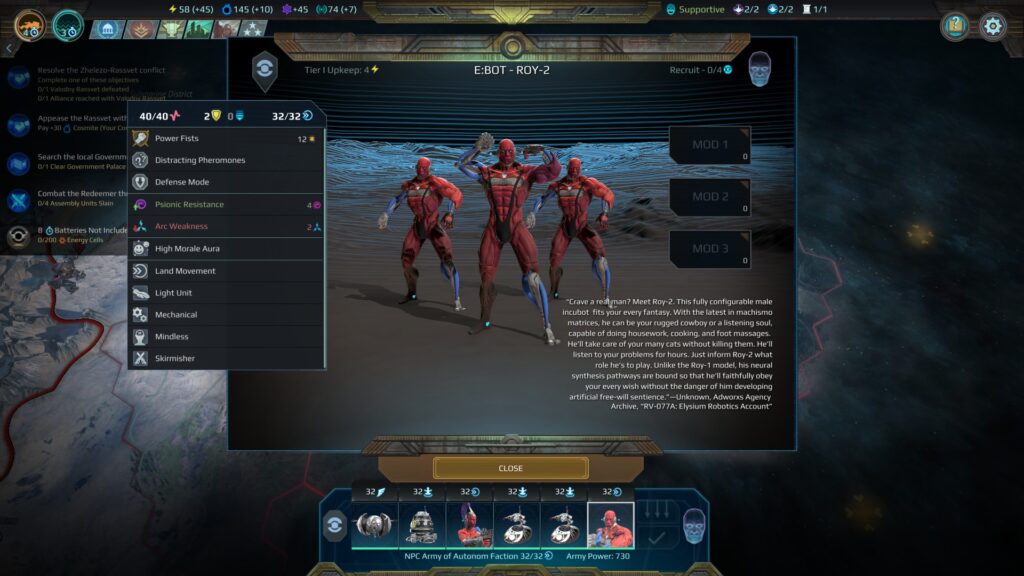
The empire management aspects of Planetfall are very similar to Age of Wonders III, for better or worse. The map is divided into sectors, each of which generally have one to three key points of interest that offer rewards or resources and bonuses that can be exploited when under your control. The larger sectors tend to be the ones suitable for establishing new colonies.
In addition to the main resources of Energy, Cosmite, Knowledge, and Influence that are used to purchase units, research technology, or trade in negotiations with other empires, each colony has its own resources that affect the rate of their growth and how quickly they can produce units and structures.
Unfortunately, this is where some of the more clunky aspects of the UI become apparent. You’ll need to click each individual colony to check out their production and statistics instead of, say, being able to just learn these things at a glance with tooltips. There certainly are tooltips, but they don’t always show what you’d like them to.
There’s a number of other eccentricities regarding the UI, map, and attempting to move units great distances. You also can’t seem to just set a colony on infinite resource production like in Age of Wonders III, so unless you just queue up the energy production option the max number of times, expect to have the game nag you every turn to set the individual production schedule of each colony.
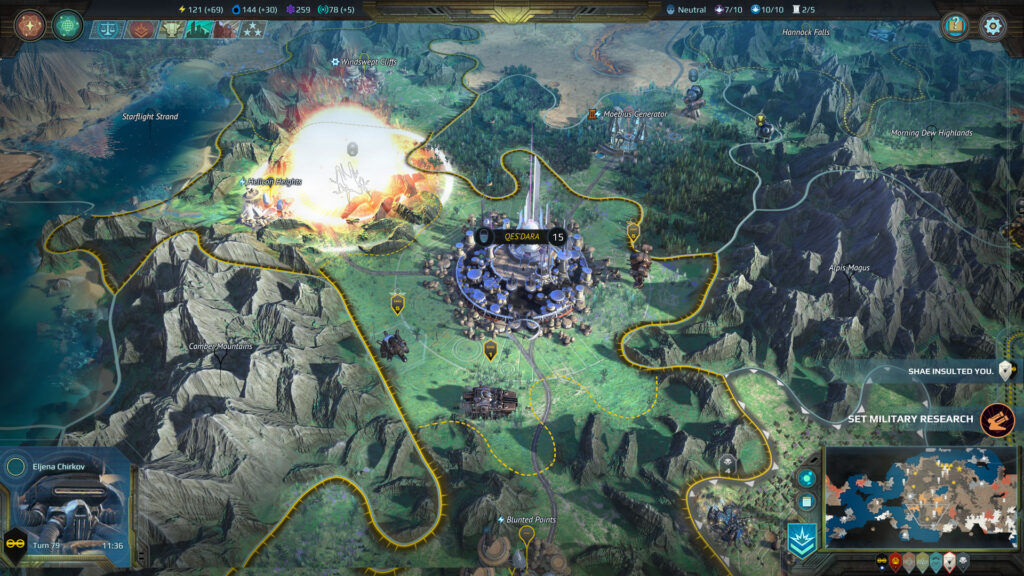
As your colonies grow and gain more colonists, you can annex nearby sectors to that colony. This gives you access to whatever resources and bonuses that sector provides, and can be exploited by building specific structures that increase the production of certain resources. The sector system allows you to specialize colonies more than in the previous game, so shopping around for ideal locations is more important than before.
Even still, the actual empire management elements of Planetfall remain fairly straightforward and uncomplicated. Like all Age of Wonders games, Planetfall is not the game for you if you are looking for obsessive levels of micromanagement with a daunting amount of options to tweak in every individual settlement.
Age of Wonders III‘s magic system returns as the more thematically appropriate Operations. These function more or less the same as spells in previous games, but instead of flinging fireballs at an enemy city, you are carpet bombing them with incendiary devices from orbital platforms. Operations come in three types: Tactical, Strategic, and Doctrine. Tactical Operations are used during battles, Strategic Operations are used in the overworld map, and Doctrines are passive, empire-wide bonuses. The number of Operations you can use in a turn are dictated by your Operational Capacity, and there’s a limited number of Doctrine slots as well. These can all be increased with research, which is also your primary way of unlocking new Operations.
The diplomacy in Planetfall is almost identical to Age of Wonders III. In other words, its kind of garbage due to the schizophrenic and indecisive AI. Negotiations are about as reliable as a coinflip, which is particularly annoying in campaign missions where the goal is to ally with a specific empire. More than once I’ve had my relationship maxed with the AI and they’d still continuously refuse requests for treaties or exchanges. The NPC factions are also quite needy, and will frequently bug you with new quests at inconvenient times or demands for resources to maintain your relationship.
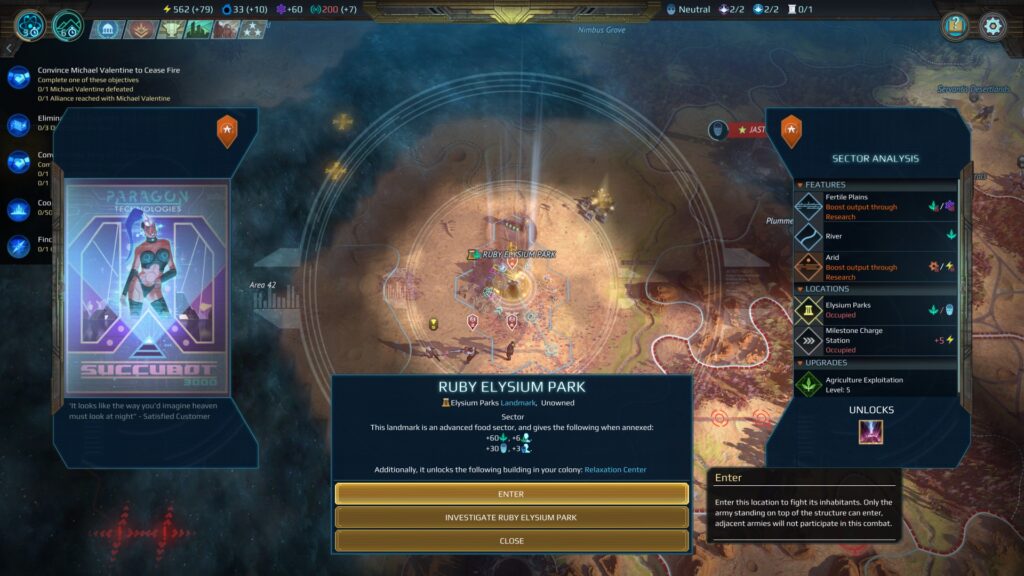
If you don’t want to make friends and rather crush all opposition beneath the titanium treads of your tanks, you’ll find that conquest is just as satisfying as ever, due in no small part to the game’s robust turn-based tactical battles. Each army stack can contain six units, and depending on how you position stacks on the overworld map before starting combat, there can be upwards of six armies involved in a battle at once.
Units use a two-action point system like in Age of Wonders III, but since this is a sci-fi game, there’s a much greater emphasis on ranged combat. Many ranged units can go into overwatch, cover is more important than previous games, and there’s a wider range of hazards and objects you can target in combat, like explosive barrels, fuel cells, or cars.
That isn’t to say there’s no melee combat at all, just that it tends to be relegated to specific assault-focused armies like the Kir’ko or feral alien wildlife. There’s also a lot more special abilities floating around, which help further differentiate the various factions and the roles their units play.
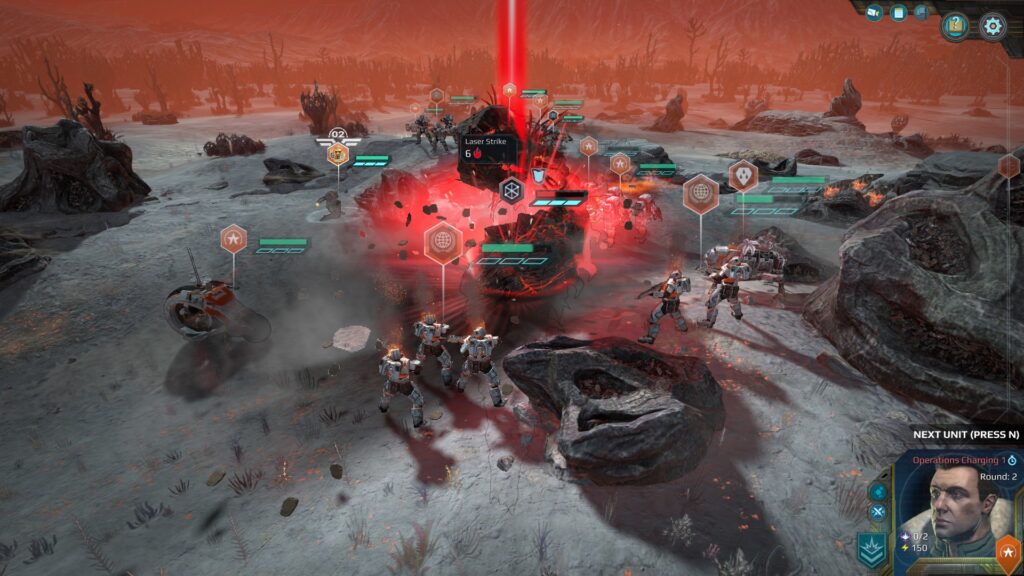
Many of the core combat mechanics in Planetfall are the same as the last game in the series, even down to a lot of the status effects, the relevance of unit facing due to flanking bonuses, and attacks of opportunity. There’s a lot of depth to discover in the combat mechanics, and the battles are definitely one of the main draws of the game.
Of course, there is still the option to auto-resolve battles if you don’t feel like fighting them, but that’s only really recommended if you have an overwhelming advantage because the auto-resolve will often screw you over with head-scratching losses that there’s no way you would have sustained in a real battle.
The AI might be unpredictable in all the wrong ways when it comes to negotiations, but its decent enough in combat. Enemies will target your weaker units whenever possible, and generally use their special abilities in logical ways. I’m not saying that the AI is a tactical genius, but they rarely make glaringly idiotic decisions.
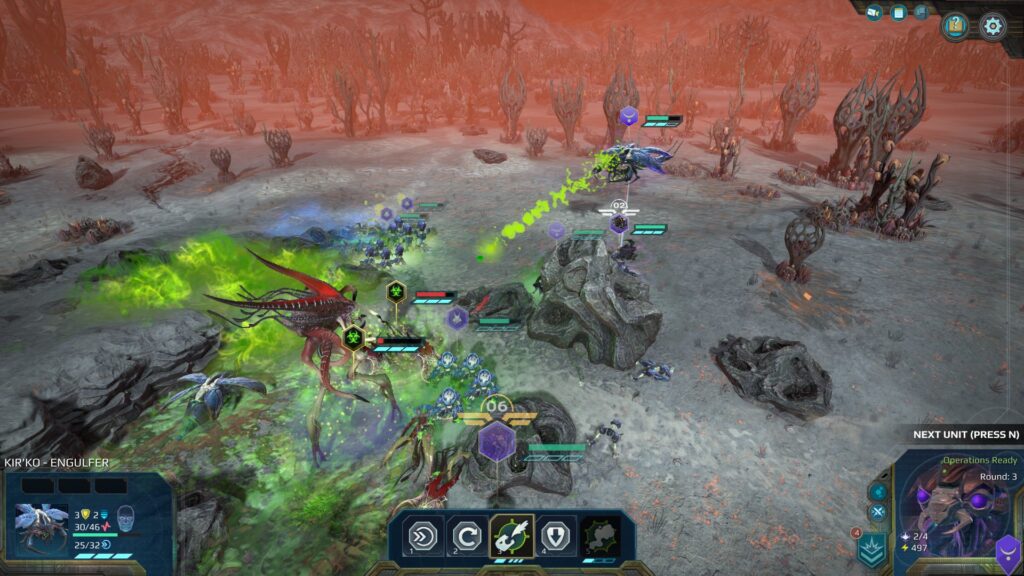
Combat is also nice because you get to see all of the game’s characterful and interesting units in action. Alien T-Rexes with laser guns, psychic jellyfish, massive bug-like monsters that can devour smaller units whole, drill tanks, and evil penguins are just a taste of the crazy creatures you’ll encounter on your quest for galactic domination. The units all look great and are generally well-animated.
That said though, some animations are undeniably less polished than others, and its not uncommon for the animations to glitch out or otherwise not play correctly. This extends to the sound assets as well. Some of the sound effects are great. Others, like the autocannons on the Imperial APC or the defensive guns on the Dvar Rockcrusher, sound extremely underpowered considering the caliber of the guns being fired.
Sound assets regularly cut out or don’t play in the same manner as the animations as well. There’s some places where there’s no music either, and I’m not sure if its an intentional design decision or if the sound just messed up again. The music that is in the game, however, is pretty good and fits the action on screen.
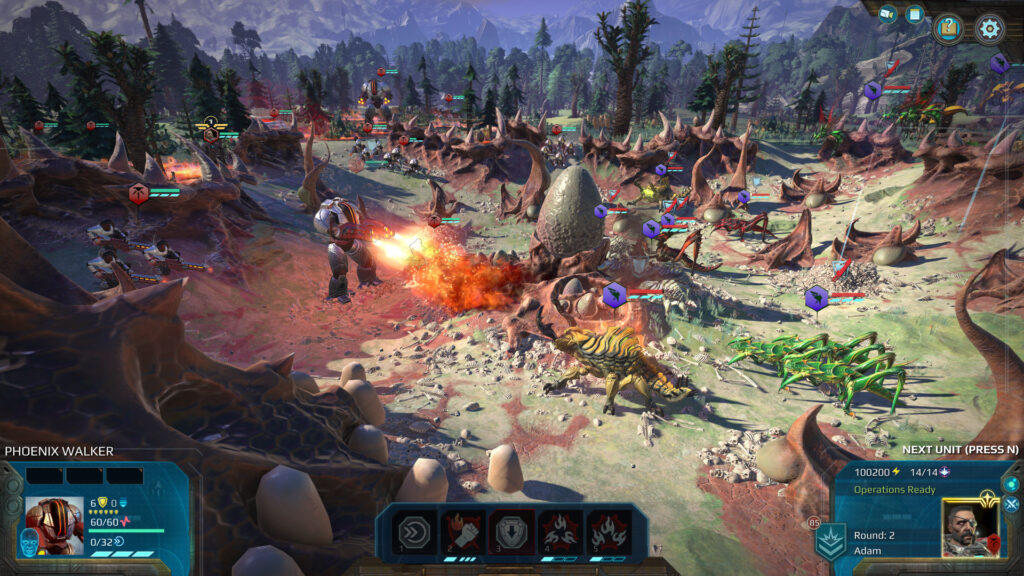
The game also suffers from the same fairly limited selection of combat maps as Age of Wonders III. That’s not to say that the combat maps are bad though. They are generally well-designed, look nice, and feature tons of obstructions, buildings, hazards, and rumble to navigate and exploit. The problem is that there’s not enough of them, so be prepared to fight on the same maps fairly frequently.
This is especially apparent in the game’s naval combat, which feels even more token than the last game. Each faction’s selection of dedicated seafaring units is extremely limited, though you can supplement your naval forces with air units.
The naval maps are also really boring, since the majority of them are just open ocean with a few scattered obstacles like chemical spills or floating debris. It creates a scenario where the naval combat just isn’t all that fun due to the lack of options and spartan maps.
From a technical standpoint, the game runs fine as well. I’ve seen some reviews that mentioned poor performance, but that was largely addressed in a prerelease patch. I did experience some drops to 40 FPS on a specific battle map, which is odd because it wasn’t even a large battle. This seems to have been a random fluke, because I’ve played massive siege battles without any issue on other maps.

While there’s still plenty of room for improvement, I’d be lying if I said I wasn’t in love with Age of Wonders: Planetfall in the same way that I was with Age of Wonders III.
Planetfall is a big step up from the previous game in many areas, though admittedly it retains many of the same flaws as its predecessor in other places. Between the six unique factions, Secret Technology trees, NPC factions, and endlessly replayable random map generator, there’s no shortage of content that will keep you occupied for a long time.
Considering how great Age of Wonders III‘s expansions were, I’m also eagerly awaiting to see what Triumph Studios adds next. If you are in the market for a solid sci-fi 4X game that isn’t overly complicated and a bit more focused on combat, then you’ll find a lot to like in Age of Wonders: Planetfall. It’ll likely be my go-to game for several more months to come, even with all its flaws.
Age of Wonders: Planetfall was reviewed on Windows PC using a review copy purchased by Niche Gamer. You can find additional information about Niche Gamer’s review/ethics policy here.